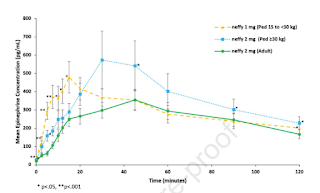Fleischer DM, Li HH, Talreja N et al. J Allergy Clin Immunol Pract. 2025 Mar 20:S2213-2198(25)00269-7. doi: 10.1016/j.jaip.2025.03.019.
Abstract
Background: Epinephrine is the gold-standard treatment for severe allergic reactions, including anaphylaxis and is typically administered via intramuscular injection. Despite epinephrine's well-documented safety and efficacy, patients may be hesitant to administer/receive injections, thereby increasing the risk of complications. neffy epinephrine nasal spray was developed to provide an additional option that may reduce dosing hesitancy.
Objective: This study was conducted to characterize neffy's pharmacokinetic and pharmacodynamic profiles in pediatric subjects, and to compare profiles between pediatric and adult subjects.
Methods: This was a phase 1, multicenter, single-dose, pharmacokinetic/pharmacodynamic study. Forty-two pediatric patients were dosed with 1 or 2 mg of neffy, based on weight. Pharmacokinetic and pharmacodynamic parameters were summarized with descriptive statistics and analyzed using a linear mixed effect model.
Results: In pediatric subjects, neffy 1 mg resulted in a slightly lower mean maximum concentrations relative to neffy 2 mg (651 vs. 690 pg/mL), which were higher than the maximum concentrations in adult subjects (481 pg/mL). While adult subjects demonstrated a marked post-dose increase in systolic blood pressure, the systolic blood pressure increase observed in pediatric patients was significantly lower and was accompanied by minimal differences in diastolic blood pressure. The effect on heart rate was similar between both pediatric and adult subjects.
Conclusion: In pediatric subjects both the 1 and 2 mg doses of neffy resulted in mean maximum concentration values that are expected to be both safe and efficacious. Age-related differences in pharmacodynamic responses were noted; however, these differences are likely attributable to expected age-based differences in physiology.


No comments:
Post a Comment